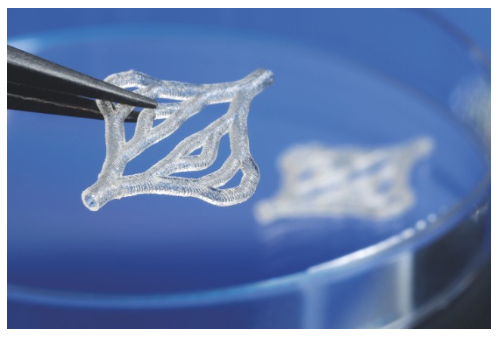 A new project is underway in Europe via Germany’s Fraunhofer Institute for Laser Technology (ILT) and their partners. Funded by both the European Union and the state of North Rhine-Westphalia, ‘High Productivity and Detail in Additive Manufacturing through the Combination of UV Polymerization and Multi-Photon Polymerization – HoPro-3D’ will run for the next three years with a focus on 3D printing that is not just fast, but also precise—a technological duo of features that is often extremely hard to achieve in one package.
A new project is underway in Europe via Germany’s Fraunhofer Institute for Laser Technology (ILT) and their partners. Funded by both the European Union and the state of North Rhine-Westphalia, ‘High Productivity and Detail in Additive Manufacturing through the Combination of UV Polymerization and Multi-Photon Polymerization – HoPro-3D’ will run for the next three years with a focus on 3D printing that is not just fast, but also precise—a technological duo of features that is often extremely hard to achieve in one package.
Fraunhofer ILT scientists hope to have it all in 3D printing through a combination of stereolithography and multiphoton polymerization processes. Project partners include:
- LightFab GmbH (Aachen)
- Bartels Mikrotechnik GmbH (Dortmund)
- Miltenyi Biotec GmbH (Bergisch Gladbach)
The team of scientists will be manufacturing new hardware that can 3D print macroscopic polymers in the ‘submicrometer range.’ Historically, such processes have been available separately in laser 3D printing with stereolithography (SLA), or with micromirror arrays in digital light processing (DLP), or microscopically with multiphoton polymerization (MPP). While SLA and DLP or a combination thereof may offer attractive resolution, build rates are usually more time-consuming.

The aim is to use the combimachine to produce branched microtubes as well as complete microfluidic systems. (Photo: © Fraunhofer ILT, Aachen, Germany.)
The scientists anticipate meeting their goal with a high-performance new 3D printer that combines DLP with MPP, including two different exposure systems depending on the users needs, whether that is in higher precision or build rate. The process relies on high-performance LEDs and a DLP chip that offers HD resolution. The integrated MPP module relies on a femtosecond laser capable of rapid scanning and microscope optics.
“The advantage lies in the interplay between the two procedures: Depending on the need, we intend to switch between the exposure systems in the process,” said Dr. Martin Wehner, HoPro-3D project manager at Fraunhofer ILT. “The challenge we face is in process control. The concept has been developed, currently an appropriate machine is being built.”

The strength of the combined process is evident when small precision parts and solid bodies come together. (Photo: © Fraunhofer ILT, Aachen, Germany.)
The expansive project team of scientists will also be creating accompanying software smart controls that automatically toggle between the two choices as required. The overall goal is to create a streamlined machine that can offer the transitioning sources—along with preventing to need to add new photo resin. This will require customizing materials and refining the combination process intricately.
“The combination of processes allows, for example, optical function elements such as lenses or prisms to be integrated directly into a larger component with great precision. Thanks to this approach, complete collimating optics for reading optical information in analysis technology can conceivably be built,” states the press release from Fraunhofer ILT, emphasizing that many different applications will benefit from this new technology—but especially biomedial analysis.
The magic of 3D printing continues to attract new users from every part of the world in many different industries, including desktop enthusiasts who also demand versatility and accuracy. The vast selection of hardware, software, and materials available is beginning to seem almost as infinite as the potential for innovation!
Almost all users today want to fabricate new prototypes and products faster, better, and stronger than ever, whether endeavoring to create an architectural project, veterinary surgical implant, or even something whimsical like a 3D printed chocolate dessert. This has led industry manufacturers to work even harder to please the growing number of consumers hungry for new features; however, the same goes for researchers in labs today who are exploring more complex ways to extend scientific studies, and especially in biomedical and bioprinting applications. Find out more about Fraunhofer ILT and their other projects here.
What do you think of this news? Let us know your thoughts! Join the discussion of this and other 3D printing topics at 3DPrintBoard.com.
Subscribe to Our Email Newsletter
Stay up-to-date on all the latest news from the 3D printing industry and receive information and offers from third party vendors.
You May Also Like
Visages Launches 3D Printed Glasses Line
French startup Visages has released a service that lets you customize your own glasses, which are then produced on demand using eco-friendly materials. The company aims to be a digital...
Materialise Empowers 3D Printing with New Innovations and Alliances at RAPID+TCT 2024
Materialise (Nasdaq: MTLS) kicked off RAPID + TCT 2024 in Los Angeles by unveiling upgrades to its flagship preparation software, Magics, and announcing new partnerships with Ansys, nTop, and EOS....
Printing Money Episode 19: Q1 Earnings Analysis with Troy Jensen, Cantor Fitzgerald
We are back with Episode 19 of Printing Money. The world does not stop turning. One not-so-profound reminder of that is the quarterly earnings reports of publicly traded companies. It...
nTop Launches Version 5 of its 3D Modeling Software at RAPID + TCT 2024
nTop, the NYC-based provider of design software used for additive manufacturing (AM), has launched nTop 5, the latest version of its flagship platform, ahead of RAPID + TCT 2024 in...































